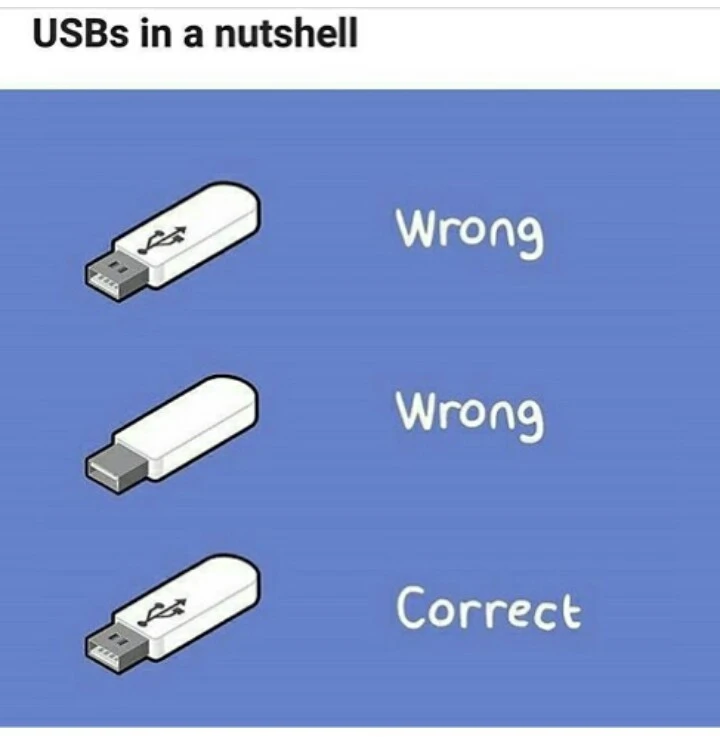I’ve literally never seen any of these except the top symbol.
I’ve never seen any of the SS 10gig or USB PD icons, but I’ve seen the rest. I’ve got Thunderbolt icons on at least 2 icons and SS USB 3.1 icons on many normal USB A ports.
No symbol for power-only ports?
These are found almost exclusively on PC/laptops/tablets. Which I’ve never seen a power port only on.
My laptop has two USBC ports. No logos of any kind. They are Thunderbolt 4. ¯_(ツ)_/¯
If you’re trying to get Lemmy to print the backslash, you need to make it a double backslash since backslash is an “escape” character that means “ignore any special formatting meaning of the next character” (among other meanings)
Reddit was the same exact way. I don’t know how people are messing it up here too.
Here, you’ve lost an arm: \
The standard might be complicated if you want the specifics, but for everyday use it’s incredibly simple, and I love it. The number of times I needed this information is 1, even though most of my devices, including an external monitor, are USB-C.
Yeah. I grew up in the days of serial ports and parallel ports, and USB in general is so much better for most purposes. (I recall plugging my first mouse into the serial port…but wait! Where will my Hayes Smartmodem modem plug into then? Also, don’t plug and unplug things from the serial port while the computer is running.)
And USB-C is even better. My tablet needs a charge? Well my laptop charger is right here… My phone is low and needs a quick charge? Well my USB-C tablet charger will give it a decent boost very quickly. No worries about getting it plugged in the wrong way, either.
I have a docking station for my work laptop, so when I had to replace my personal laptop, a laptop that supported USB-C power delivery was mandatory. I don’t use it with the docking station very often, but knowing I can without an issue is great. My wife also has a Macbook that works on the docking station, too, in case she ever wants to use my dual monitor setup. All three laptops, from three different brands, are just plug in and go.
I can’t imagine how you think it’s incredibly simple. These things are hell to explain to pretty much any normal person who needs to know why there’s no picture on the monitor or why their laptop/phone is not charging, or why the keyboard isn’t working in BIOS (no USB 3 support so you gotta switch to a USB 2 port). Add to that the combinatorial complexity of different cables and hubs supporting different things, and no tools for troubleshooting what feature is missing (and where in the chain) or what is suboptimal.
Worse, sometimes it’s my boss who thinks they can cheap out and get a USBC dock instead of a proper dock, forcing me to run at non-native lower resolutions or unable to use a second screen.
I think that maybe having two similar lightning bolt symbols that mean different things wasn’t the best design decision that the USB guys could have made.
The ‘Thunderbolt’ symbol is Intel’s proprietary technology. Apple and Intel made it. First apple registered Thunderbolt as a trademark but later they transferred it to Intel. The lightning bolt icon which supports fast charging phones or other devices when connected to the laptop is different and developed by the USB guys.
One should not that though Thunderbolt over USB-C offers the same speed and connectivity as a native thunderbolt cable, the native cable can be 40m long whereas the USB-C implementation is max 2m
Things are muddied a bit though because USB 4 has built in support for thunderbolt
Everything defined in the Thunderbolt 3 spec was incorporated into the USB 4 spec, so Thunderbolt 3 and USB 4 should be basically identical. In reality the two standards are enforced by different certification bodies, so some hardware manufacturers can’t really market their compliance with one or the other standard until they get that certification. Framework’s laptops dealt with that for a while, where they represented that their ports supported certain specs that were basically identical to the USB 4 spec or even the Thunderbolt 4 spec, but couldn’t say so until after units had already been shipping.
best design decision that the USB guys could have made
lol the whole history of usb is full of design fuckyous

I mean, they fixed that with USB-C (after introducing one small USB port, mini-USB, that wasn’t reversible, with the tensioners that wear out on the expensive (device) side and and then introducing micro-USB which fixed the tensioners but still wasn’t reversible).
I’d personally kind of like to have magnetic breakaway connectors or similar so that I can’t damage devices if they fall, especially given that micro-USB and USB-C aren’t the most-physically-robust of connectors. Adapters with proprietary ways to do this exist:
https://www.amazon.com/MoKo-Magnetic-Adapter-Straight-Thunderbolt/dp/B0CGLM6PYN
But they aren’t part of the USB spec. If they ever switch to something like that, we’re gonna have another phase of incompatibility.
USB-A: the 4 dimensional port.
Brother, now that thunderbolt 4 has been introduced it’s even more confusing. Some of these labels are already out of date
All they had to do was require stamped icons on the ends of the plugs in the spec, and instead we have the current cable mystery clusterfuck 🤦
The USB-C standard and particularly the USB PD (power delivery) is so complex it almost feels comical.
The PD standard document (freely available on usb.org) is over 800 pages long and features a lengthy part about the role of the cable alone which is mostly hidden from the user. Here’s a short video about this issue: https://www.youtube.com/watch?v=6bZ0y9G-4Pc
Do you regularly read highly technical whitepapers? I don’t see how an 800 page document is comical for something that works so well.
ai generated lol
What’s AI generated?
Me. Sigh.
That is not what I’m suggesting. I’m not saying charging only cables shouldn’t exist. I’m saying what everything does should be clearer.
It gets even better, each function of the port also needs proper support from the cable. Often cables do not support the full spec of usb to cut costs.
While the symbols in the post are often put on computers, for usb cables this is seldom done (only a few brands do).
Source: had to find a cable that supports both DP and PD to connect a portable external monitor after I lost the original cable. (1/9 cables worked)
Yes, this is incredibly annoying and it’s also the reason why some USB cables cost more than others, even they may look the same superficially.
One of those cables that don’t work is rated for like 120W, with gigabit transfer speed… But it refuses to transmit display… Like bruh
1080p at 60 Hz is 4.4 gigabit
USB-C video is usually DisplayPort Alt Mode, which uses a completely different data rate and protocol from USB.
Even using old 2016 hardware, a computer and USB-C cable that both only support 5 Gbps USB (such as USB 3.1 Gen 1) can often easily transmit an uncompressed 4K 60Hz video stream over that cable, using about 15.7Gbps of DisplayPort 1.2 bandwidth. Could go far higher than that with DP 2.0.
Some less common video-over-USB devices/docks use DisplayLink instead, which is indeed contained within USB packets and bound by the USB data rate, but it uses lossy compression so those uncompressed numbers aren’t directly comparable.
Didn’t really think about that one but you’re right damn… (Looked it up, and it depends on the bit depth etc, but it’s around 3.2Gbps for the display settings if I’m correct)… So that explains a lot
That sounds like a dedicated charging cable. So yeah, they will (if at all) only transfer data slowly and not support any extras features like displayport.
A dedicated charging cable wouldn’t have “gigabit speed”
No USB cable has “gigabit speed”. It probably has 480 Mbps (USB 2.0 standard).
Maybe he meant a 5 Gbps Gen1 cable. That would be “gigabit speed” but still rather slow by today’s standards and won’t support DP. They are pretty cheap these days, so wouldn’t be suprising to see left over stocks being sold as charging cables.
No USB cable has “gigabit speed”. It probably has 480 Mbps (USB 2.0 standard).
What? I’m either misunderstanding you or this statement isn’t correct. Having USB cables that can move data at gigabit rates has been common for quite some years.
Here’s the latest stuff:
https://en.wikipedia.org/wiki/USB4
Bitrate
20 Gbit/s
40 Gbit/s
80 Gbit/s
120/40 Gbit/s asymmetricWhat? I’m either misunderstanding you or this statement isn’t correct
I meant that no USB standard actually has exactly 1 Gbit/s. I even mention that next one if 5Gbit/s. Just a misunderstanding I think.
Yeah, it’s gotten so bad I eventually ordered a USB cable checker to figure out what any given USB cable is capable of (and to see if the cable has gone flaky, which seems to happen a lot). I haven’t received it yet so I don’t know if I can recommend this item, but … gosh darn you sure need something like this.
Sometimes people want to charge their phone in an outlet 10 feet from their airport seat.
Sometimes people want to transmit 8k video.
It’s not physically possible to do both tasks with the same cable.
But because USB is a flexible standard, we don’t have two incompatible specs to do the same thing. So when you get out of the airport and to your meeting, you can actually plug your phone into the meeting room projector for your business presentation. That’s a win.
Luckily, all new PC seem to choose Thunderbolt over only alt mode, which makes stuff more easy, since they have the flash on the cable (but are also more extensive, I gear
For that portable monitor, you should just need a cable with USB-C plugs on both ends which supports USB 3.0+ (could be branded as SuperSpeed, 5Gbps, etc). Nothing more complicated than that.
The baseline for a cable with USB-C on both ends should be PD up to 60W (3A) and data transfers at USB 2.0 (480Mbps) speeds.
Most cables stick with that baseline because it’s enough to charge phones and most people won’t use USB-C cables for anything else. Omitting the extra capabilities lets cables be not only cheaper but also longer and thinner.
DisplayPort support uses the same extra data pins that are needed for USB 3.0 data transfers, so in terms of cable support they should be equivalent. There also exist higher-power cables rated for 100W or 240W but there’s no way a portable monitor would need that.
I legit have never seen the battery used at all. They often use a plug, a lightning bolt confusingly, or don’t even label it at all.
SuperSpeed is not a “legacy” name.
It’s the name of a transfer rate.
I do not trust the maker of this infographic if they cannot understand some basic facts.
USB = Unintelligible Symbols of Bewilderment
A small correction on USB PD…
It’s not just USB PD that supports power delivery: Standard USB from way back in 1.0 also supports power delivery to devices as standard, but it’s only up to 100mA in USB 1.0, 500mA in USB 2.0 and 900mA in USB 3.0, all at 5V.
USB PD is a dedicated power delivery USB protocol that supports much higher currents (up to 5A) as well as dynamically configured voltages (so, not fixed as 5V anymore) though it’s all negotiated so your 5V-only phones isn’t going to just get burned with 20V from a USB PD charger.
Since Power = Current * Voltage USB PD can put out quite a lot of power for supporting devices (the maximum depending on what both sides support), which means much faster transmission of power via USB which for example means faster charging of chargeable devices via USB with USB PD.
Anyways, the point being that even really old USB 1.0 can charge your device (just really really slow, though you’ll be hard pressed to find anything that doesn’t support at least USB 2.0 which can send 5x the current of 1.0 hence charge 5x faster than it), and that standard charging speed goes up with each new Standard USB generation since each has a higher maximum current than the previous one, so for example a standard USB 3.1 charger without USB PD support can still push a nice amount of power down the line to charge devices. It’s just that with USB PD things really take off (though only up to a shared maximum that both sides support) and it can push enough power to support larger devices such as full-blown monitors or even charging notebooks.
Also PD extended range or something goes up to 48V 5A
Why not label the ports and cables with:
- 10Gb/s
- 2.1Amps
- 1080p at 60hz
It’s future proof and doesn’t need a decoder manual other than basic literacy. It can be in whatever language the fucking keyboard is. If you want to be redundant but even more clear:
- Universal Serial Bus -> (this hole right here)
- Speed: 40Gb/s
- Power: 2.4Amps
- Audio/Video: 4K at 120Hz or 8K at 30Hz
Amps are not power
So do like they did for video and out 2A @ 5V. Now you have power.
But if its USB PD it can be more than 5V though.
That’s why you specify it there:
2A@5-15V or something.
Sorry. I must have missed that. I am working on 3 hours of sleep rn due to a flight I need to catch.













